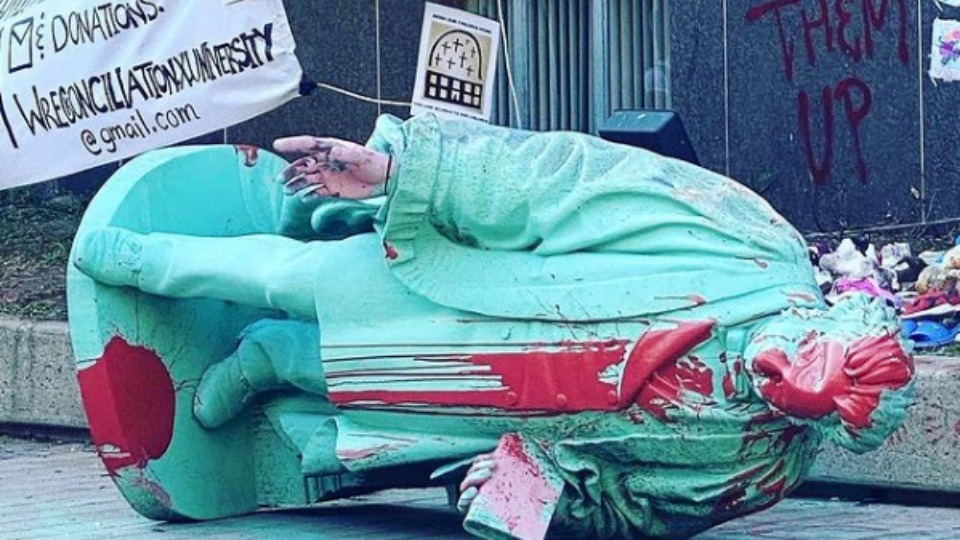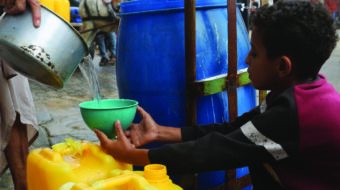
TORONTO—The statue of Egerton Ryerson at the Toronto university that bears his name was pulled down by protesters Sunday evening and beheaded. Ryerson is widely seen as one of the architects of Canada’s racist residential school system, which for decades sought to eliminate Indigenous cultural traditions and languages.

More than 1,000 protesters converged on the statue Sunday following a march from the Ontario provincial legislature building at Queen’s Park. The demonstration was part of a wave of protest that has swept Canada since news broke last weekend that the bodies of at least 215 Indigenous children had been discovered in an unmarked mass grave on the grounds of the former residential school in Kamloops, British Columbia.
Toronto Police arrived following the statue’s fall from its place of honor and took photographs but made no arrests. By late Sunday evening, protesters returned with a saw and removed Ryerson’s head, which was covered in red paint to represent the blood of residential school victims. At the base of his former perch lay 215 pairs of children’s shoes, one for each of the bodies found in Kamloops.
The Kamloops Indian Residential School, which operated from 1890 to 1969, was one component of a vast Canadian government system aimed at eradicating Indigenous identity. Over the course of more than a century, at least 150,000 First Nations children were taken from their families and communities and shipped off to state-funded church-run boarding schools; many never returned.
At the schools, authorities forced conversion to Christianity on the children, and they were forbidden from speaking their native languages. The facilities were plagued by physical, mental, and sexual abuse, and as many as 6,000 children are estimated to have died while attending.
Ryerson, a Methodist minister and educator in 19th century Canada, is considered one of the main designers of the residential school system. His advice was a central influence in the Canadian government’s decision to establish the schools.
In an 1847 report to the Department of Indian Affairs, Ryerson had argued that “Indians should be schooled in separate, denominational [Christian], boarding, English-only, and agriculturally-oriented” institutions. He held that being farm workers and agricultural laborers “fortified of course by Christian principles” was the “most suitable employment of the civilized Indians.”
The schools not only sought to turn Indigenous peoples into a source of exploitable labor; they also served to weaken collective resistance to resource theft and land expropriation during the crucial years of Canada’s economic development. The residential school system was part of the effort to open up vast tracts of Indigenous territory for expanding Canadian capitalism.
A six-year investigation by the Truth and Reconciliation Commission of Canada concluded in 2015 that the residential school system amounted to cultural genocide. The discovery of the 215 children in Kamloops has put the schools back at the center of Canadian politics. First Nations leaders say the discovery is probably only the first of many more to come, while Prime Minister Justin Trudeau claims his government will not hide from the truth and vowed to take more action.
Sam Howden, a member of Ryerson University’s Indigenous Student Association, hailed the toppling of the statue Sunday but told CP24 television that he hopes the drive for change will go beyond the excitement of that single moment.
“I would like this to be a sustainable thing where we see change at the institutional level—to take away the name, to take away the statue, and have a larger conversation about colonial violence and white supremacy in this country,” he said.

Howden is also an organizer with the “X University” campaign, a grassroots effort pushing university officials to strip Ryerson’s name from the institution and reckon with their namesake’s racist legacy. Hauling down the statue, Howden said, was not vandalism, but rather an act “to bring attention to the violence that has been endured by many different folks because of Egerton Ryerson.”
The statue became a target for protesters last summer during the global anti-racist uprising following the murder of George Floyd in Minneapolis. During those protests, many statues of Confederate leaders in the U.S. and racist colonial officials in other parts of the world were pulled from pedestals. The Ryerson statue was splashed with red paint and became a hub for demonstrations. The Kamloops mass grave discovery brought protesters back again this past week.
Following the toppling Sunday, Ryerson University president and vice-chancellor Mohamed Lachemi announced the statue will not be restored or replaced. He urged a university task force created to deal with the Egerton Ryerson legacy to continue its work, including looking into a possible rebranding of the institution. Many student groups are not waiting around for official recommendations, however, and have already changed their names.

Brianna Olson-Pitawanakwat, an organizer of the Sunday protest and an intergenerational survivor, told Canadian television that healing from the residential school cultural genocide will only come when the complete truth is out. She said the Canadian government, the Catholic Church of Canada, the Vatican, and others who played a role in the system must disclose everything they know.
“Give all the documents up,” she said. “Give all of the capacity for these schools to be searched and for more bodies of children to be found, and finally lay to rest in a proper way.”
Another participant, Suzanne Smoke, a leader with the American Indian Movement – Southern Ontario, said even more supporters should be hitting the streets and pressuring the government. “Canadians need to be mourning with us…need to be just as upset and appalled and tearful.”
Referring to the 215 bodies discovered in Kamloops, Smoke said, “Those were our children. Those were our next seven generations, and they’re lost. How many more are we going to unearth?”












Comments